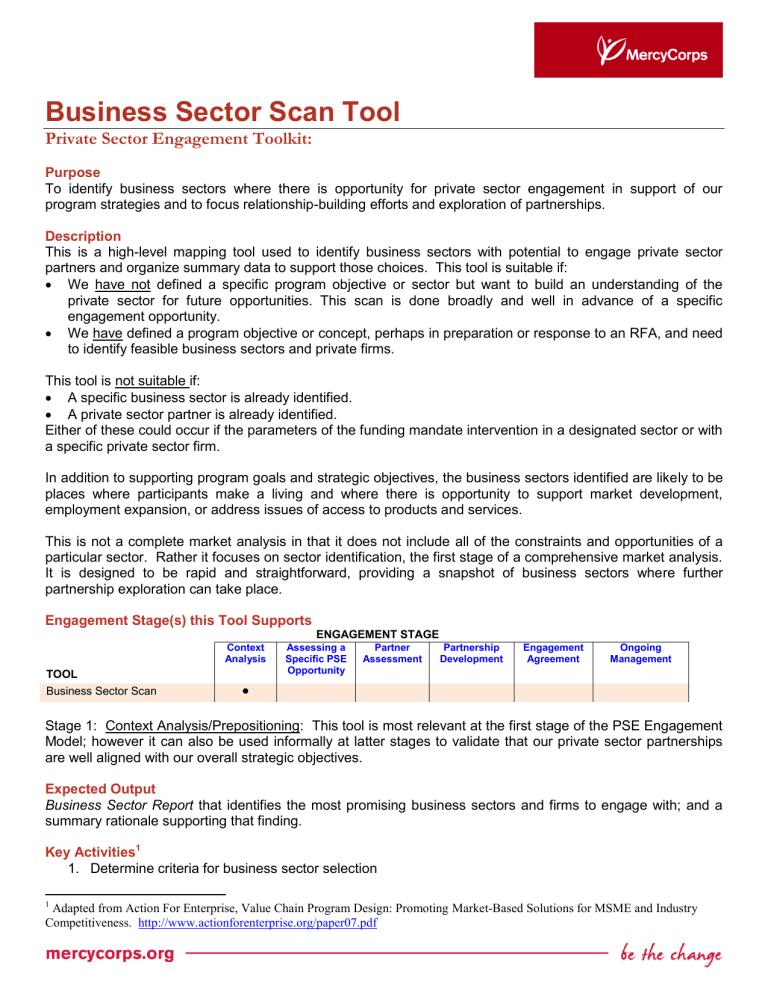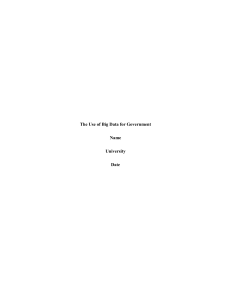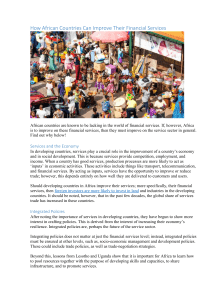
Business Sector Scan Tool Private Sector Engagement Toolkit: Purpose To identify business sectors where there is opportunity for private sector engagement in support of our program strategies and to focus relationship-building efforts and exploration of partnerships. Description This is a high-level mapping tool used to identify business sectors with potential to engage private sector partners and organize summary data to support those choices. This tool is suitable if: We have not defined a specific program objective or sector but want to build an understanding of the private sector for future opportunities. This scan is done broadly and well in advance of a specific engagement opportunity. We have defined a program objective or concept, perhaps in preparation or response to an RFA, and need to identify feasible business sectors and private firms. This tool is not suitable if: A specific business sector is already identified. A private sector partner is already identified. Either of these could occur if the parameters of the funding mandate intervention in a designated sector or with a specific private sector firm. In addition to supporting program goals and strategic objectives, the business sectors identified are likely to be places where participants make a living and where there is opportunity to support market development, employment expansion, or address issues of access to products and services. This is not a complete market analysis in that it does not include all of the constraints and opportunities of a particular sector. Rather it focuses on sector identification, the first stage of a comprehensive market analysis. It is designed to be rapid and straightforward, providing a snapshot of business sectors where further partnership exploration can take place. Engagement Stage(s) this Tool Supports ENGAGEMENT STAGE Context Analysis TOOL Business Sector Scan Assessing a Specific PSE Opportunity Partner Assessment Partnership Development Engagement Agreement Ongoing Management Stage 1: Context Analysis/Prepositioning: This tool is most relevant at the first stage of the PSE Engagement Model; however it can also be used informally at latter stages to validate that our private sector partnerships are well aligned with our overall strategic objectives. Expected Output Business Sector Report that identifies the most promising business sectors and firms to engage with; and a summary rationale supporting that finding. Key Activities1 1. Determine criteria for business sector selection 1 Adapted from Action For Enterprise, Value Chain Program Design: Promoting Market-Based Solutions for MSME and Industry Competitiveness. http://www.actionforenterprise.org/paper07.pdf 2. 3. 4. 5. Prioritize selection criteria Select potential business sectors Rank business sectors Report results 1. Determine Criteria for Business Sector Selection: The first step is to identify criteria that will be used to evaluate potential business sectors. Determining criteria requires strategic thinking about our country strategy, program goals, regional value proposition and agency strategic roadmap, as well as the focus of a particular program concept or RFA if relevant. Criteria selection should also reflect the Mercy Corps’ capacity, experience, and expertise. The following documents may be useful: a. Strategic Roadmap and regional strategic value propositions: Review the annual Mercy Corps Strategic Roadmap and any regional strategic goals that have been developed. Consider how different criteria overlap with the strategies outlined in those documents. b. Country Strategy: Consider how the annual country strategy intersects with potential criteria. This can help identify places where private sector engagement will best fit with other programing in that country. c. Program Goals: If this scan is in response to a specific program or project request, mapping the selection criteria to the program goals is a priority. A sample list of selection criteria is below. This is a partial list and specific criteria should be identified based upon the context when the scan is being undertaken. Criteria Description Market Demand and Growth Potential Relevance for inclusive growth Opportunities For Linkages Employment Generation Strategic Alignment Private Sector, Donor or Government Interest Increases in Productivity Program Synergy Evidence of strong effective demand for products being produced Producers have ready market for products but are unable to meet demand Program Goal Support Reputation Reach Formal vs. Informal Relevance and importance to the target populations (i.e. employment, vital services, impact on living standards.) Potential forward/backward linkages between large and small enterprises in this sector. Large buyers are overlooking MSMEs to meet their demands. Potential for enterprises (large and small) to create new employment opportunities for as the business sector develops or expands. Alignment or overlap between this sector and cross-cutting agency strategic objectives such as gender or youth development. The local, regional, or international private sector has demonstrated interest. Donors have expressed interest in developing the sector. Government interest in a sector could support positive linkages with government services, and favorable policies. Potential for technologies or management systems to increase the productivity and earnings of enterprises in the sector. Existing Mercy Corps programs can provide synergy and complementary activities to this sector or vice-versa. Opportunity for the sector to contribute to overall program goals (i.e. the importance of the retail sector for energy poverty) Reputation of private sector in this sector, both in general and for specific companies. # and size of companies in this sector This business sector is situated more predominantly in either the formal or informal sector 2. Prioritize Selection Criteria The list of criteria now needs to be prioritized based on the overall context, considering governance issues, the business enabling environment, internal capacity and interest, other relevant programming and external influences such as the short-and-medium term funding environment. Summarize the selection criteria, assigned priority, and rationale for the prioritization. Table 1: Example from a program that will support youth education and livelihood development Selection Criteria Potential for youth employment generation Opportunity to support informal sector business development Priorit y 1 2 Rationale Program specifically focuses on creating employment opportunities for youth. Recognition that the formal sector is significantly undeveloped constraining employment opportunities and job growth. 3. Select Potential Business Sectors: The next step is to research potential business sectors in which to engage. Depending upon why this tool is being used and the engagement stage, the criteria prioritized above may inform or limit this research. For example, many sectors could support the 1st priority listed in Table 1 (youth employment generation), while only certain sectors support the 2nd priority (operating in the informal sector). There is not a particular order that should be followed for doing the research outlined below. Research is categorized into secondary research (reviewing other reporting and research) and primary research (conducted first-hand). It is often best to triangulate sources of research. 3.1. Secondary research: A good starting point is to access existing studies, reports, or statistics on the overall business environment and specific sectors. These can be found with national and local government agencies, national and local business associations, multi-lateral agencies, development actors and civil society groups. Web research: Primarily conducted through the internet this research may uncover relevant documentation. such as business surveys, The American Chamber of Commerce has information on local economies in over 100 countries focused on high value and export oriented sectors. Host country government documents: Depending upon the country, there may be good data on different sectors potentially available from a relevant government agency (i.e. statistics office, Ministry of Agriculture, Ministry of Trade, research institutions or universities. Multi-lateral agencies: These include The World Bank, IFC, regional development banks (e.g. Asian Development Bank, IADB) and the United Nations (e.g. UNDP, FAO, etc.) (See Resources Section for a list of sample websites and reports.) National and local Business Associations: This includes trade associations, chambers of commerce. Mercy Corps documentation: Program reports, grant applications and research that we have completed related to a particular country may provide a window into relevant previous experience and opportunity. Development actors and civil society groups: Including other INGO’s, local NGO’s, donors. 3.2. Primary Research: Networking: This is perhaps the most important method due to the challenges of finding current and relevant documentation in the countries where we operate, in addition to issues created by the context (post-conflict, or post-disaster). In those circumstances, information on business sectors may be best collected from interviews, surveys, and/or workshops with key informants (who have good general knowledge of the local economy). Identifying those key informants is a crucial first step. Often this takes extensive time and effort to build trust and relationships. Developing relationships with “connectors” – individuals who can connect you to other informed actors and make introductions – is particularly helpful. Key Informant Interviews: Consultations with value chain entrepreneurs, support service providers or other stakeholders who can provide an overview and/or preliminary information on a business sector. This could also include meetings with relevant public sector agencies. (i.e. MOT, MOA, statistics office, forestry office). These interviews would let you know what sectors are thriving sectors where the poor are engaged and impacted. Internal Interviews: If this is a country where Mercy Corps has experience, the in-country field team may be a great resource. They may have observational experience that is relevant related to the prioritized criteria. Depending upon the context (i.e. size of the team, geographical dispersion, etc.), the structure of these interviews will be different (individually, in groups, in person, or over the phone, etc.) Consider creating a simple survey to structure your initial interview with the field team. Market Observation: While market observation may not provide a comprehensive or structured picture of different business sector, identifying what products or services are available and are missing in the market can clarify other data points. Observation is an opportunity to monitor market relationships between sectors and gain insight on the importance of inter-connected markets. It is noteworthy that none of these approaches are intended to be participatory at this stage as the scan is designed to provide a high-level picture of sectors in which to pursue engagement,. 4. Rank Business Sectors Once a list of business sectors has been created, it may need to be narrowed down to focus on those with the most potential. That can be done by rating each sector against the criteria selected and prioritized in Step 2. During this exercise, a matrix is completed which shows the relative ranking of each business sector (i.e., high, medium, low) against the two highest priority selection criteria. This ranking is not a quantitative process, but it should be as objective as possible. Before ranking, it may be helpful to revisit the priorities assigned in step 2, as it may be that the business sector research that was completed in step 3 influences those priorities. For example, in the table below the two selection criteria from step 2, "support informal sector business development" and "youth employment generation" are presented - one on each axis of the matrix. Business sectors that fall in the clear area (i.e. high in either criteria or medium in both criteria) are added to the Business Sector Report in relative order. Any business sector that falls within the shaded area is considered less attractive than the other more higher-rated business sectors and would be given lower priority for further consideration. Potential to support formal sector business development High Most Potential Medium Low Least Potential Low Medium High Potential for youth employment generation Second Pass: It may be that a second pass is required so that sectors can be evaluated against more than the two highest-ranked criteria. In that instance, this step should be repeated with the next two highestranked criteria. Business sectors that fall into the clear area on the second pass should be added to the Sector Report below those from the first pass. There is also the possibility of using a numerical scoring system to more quantitatively rank the sector, but given the use of this only to inform where we should investigate engagement (and not to identify value chains for program design), that extra step is typically unnecessary. 5. Report Results The last step of the Business Sector Scan Tool is to document the findings and capture important considerations that should be explored further. The Sector Report (sample below) provides a form for capturing the business sector identified for further exploration and the key information related to that sector. The business sectors should be listed in ranked order based upon step 4, and the remaining information completed based upon the research previously completed. Sector Report (sample) Business Sector Description Rationale Advantages Disadvantages Key Questions Business Sector: List the potential business sector in as specific terms as possible Description: Describe the business sector including the key attributes relevant to a program and to private sector engagement. Rationale: Summarize the reasons this is a good sector to partner with. What are the forward and/or backward linkages with the most development potential? Which selection criteria are well supported, and which are perhaps less? Advantages: Identify other advantages beyond the selection criteria that should be considered regarding this sector. Challenges: Outline any challenges related to engaging with private firms in this sector. Key Questions: List any notable outstanding questions that are important to consider as we move forward with firms in the sector. Supporting documents / Resources Following are some specific resources from multi-lateral agencies. United Nations Human Development Reports: Website providing access to the annual Human Development Reports that also includes a searchable database to access development reports for specific countries. http://hdr.undp.org/en/humandev/ United Nations Food and Agriculture Country Profiles: Includes country-specific data related to natural resources, economics, agriculture, fisheries and aquaculture, forestry, technical cooperation, biotechnology , climate change and food security. http://www.fao.org/countryprofiles/default.asp?lang=en World Bank: Website has country-specific resources that include extensive context and background data as well as specific information about World Bank programs. http://web.worldbank.org/WBSITE/EXTERNAL/COUNTRIES/0,,pagePK:180619~theSitePK:136917,00.html Doing Business Reports: Annual World Bank publication that assesses the business environment in specific countries and includes information about the overall business sectors. http://www.doingbusiness.org/ CONTACT Mercy Corps Global Headquarters 45 S.W. Ankeny Street Portland, OR 97204 503.896.5000 800.292.3355 Ted Volchok Senior Advisor, Economic and Market Development tvolchok@mercycorps.org 09-14



